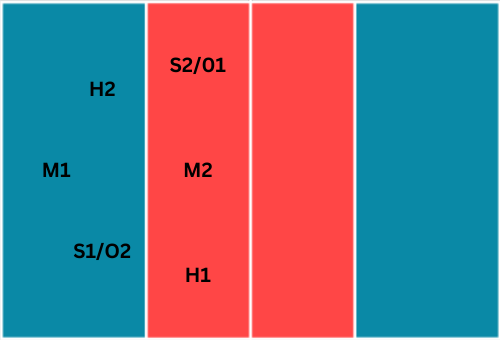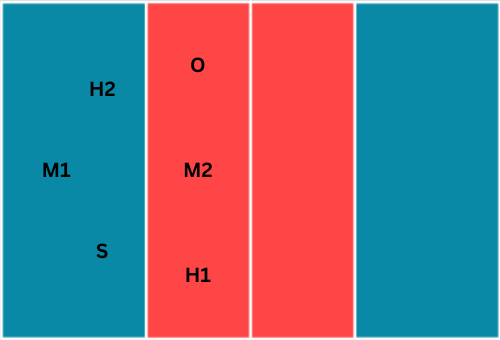Volleyball Rotations Explained

Volleyball is an exciting and fast paced team sport that requires strategic coordination among players. One crucial aspect of the game is volleyball rotations. In this article, you’ll find volleyball rotations explained and learn about their significance and how they influence the gameplay.
What are Volleyball Rotations?
Volleyball rotations are a structured system that determines the initial position of each player on the court. These rotations are designed to create an optimal team formation that maximizes offensive and defensive strategies while adhering to the rules and regulations of the game.
Understanding the concept of volleyball rotations is crucial for players, coaches and enthusiasts alike. It allows teams to effectively distribute their players’ skills and abilities across different positions, creating a well rounded and dynamic gameplay experience.
Basic Volleyball Rotations
In volleyball, there are six basic rotations, numbered from 1 to 6. Each rotation dictates the position of players on the court and provides a framework for various offensive and defensive strategies. Let’s take a closer look at each rotation:
Rotation 1:
- Setter in the right-back position
- Middle blocker in the middle-front position
- Outside hitter in the left-front position
- Opposite hitter in the right-front position
- Libero in the left-back position
Rotation 2:
- Setter in the left-back position
- Middle blocker in the middle-front position
- Outside hitter in the left-front position
- Opposite hitter in the right-front position
- Libero in the right-back position
Rotation 3:
- Setter in the middle-back position
- Middle blocker in the middle-front position
- Outside hitter in the left-front position
- Opposite hitter in the right-front position
- Libero in the left-back position
Rotation 4:
- Setter in the middle-back position
- Middle blocker in the middle-front position
- Outside hitter in the left-front position
- Opposite hitter in the right-front position
- Libero in the right-back position
Rotation 5:
- Setter in the left-back position
- Middle blocker in the middle-front position
- Outside hitter in the right-front position
- Opposite hitter in the left-front position
- Libero in the right-back position
Rotation 6:
- Setter in the right-back position
- Middle blocker in the middle-front position
- Outside hitter in the right-front position
- Opposite hitter in the left-front position
- Libero in the left-back position

Importance of Volleyball Rotations
Volleyball rotations play a crucial role in the overall dynamics of the game. Here are a few key reasons why rotations are essential:
Creating a balanced team: By strategically rotating players, teams can ensure that the skills and abilities of each player are evenly distributed across different positions. This creates a balanced team where every player contributes their strengths to maximize the team’s performance.
Maximizing offensive and defensive strategies: Rotations allow teams to position their players strategically, enabling effective offensive and defensive plays. Different rotations create opportunities for varied attacking angles and defensive coverage, keeping the opposing team guessing and enhancing the overall team strategy.
Strategy and Positioning in Volleyball Rotations
Proper positioning in volleyball rotations is vital for executing successful plays. Let’s take a closer look at the positioning of different players in each rotation:
Setter positioning: The setter plays a pivotal role in coordinating the team’s offense. They are responsible for setting up the ball for the hitters and determining the attacking options. The setter’s positioning varies depending on the rotation but usually involves being closer to the net to facilitate quick and accurate sets.
Middle blocker positioning: The middle blocker is positioned near the net and plays a crucial role in both blocking and attacking. Their positioning depends on the rotation, but they typically align themselves between the setter and the outside hitter to provide a strong defensive presence at the net.
Outside hitter positioning: The outside hitter is one of the primary attackers in volleyball. They are positioned on the left or right side of the court, depending on the rotation. Their role is to attack the ball from the outside and contribute to both the offensive and defensive aspects of the game.
Opposite hitter positioning: The opposite hitter is the counterpart to the outside hitter and is positioned on the opposite side of the court. They are responsible for attacking from the right side and are often relied upon for powerful hits and blocks.
Libero positioning: The libero is a specialized defensive player who excels in receiving serves and making precise passes. Their primary role is to provide stability and control in the back-row defense. The libero’s positioning depends on the rotation but usually involves being in the middle-back position.
Transitioning Between Rotations
Smooth transitions between rotations are crucial for maintaining the team’s momentum and minimizing disruptions. Here are a few key points to consider when transitioning between rotations:
Substitutions and player changes: During rotations, teams have the opportunity to make substitutions and player changes. Coaches strategize these changes to optimize the team’s performance, taking into account individual player skills, tactical considerations and game situations.
Managing rotation switches effectively: As players transition between rotations, effective communication and awareness are essential. Players must understand their new positions and responsibilities, ensuring a seamless transition without confusion or errors. Constant communication and practice contribute to smoother rotation switches.

Advanced Volleyball Rotations
While the basic rotations provide a solid foundation, advanced teams may employ specialized rotations to exploit specific strategies and match situations. These rotations are often tailored to the team’s strengths and the weaknesses of the opponents. Some advanced rotation strategies include:
Double setter rotations: In these rotations, two setters are utilized to maximize the team’s offensive options. This allows for quick and varied sets, creating confusion for the opposing team’s defense and opening up opportunities for powerful attacks.
Stacked rotations: Stacked rotations involve positioning multiple hitters on the same side of the court, creating a concentrated offensive force. This strategy can overwhelm the opposing team’s block and create gaps in their defense, leading to successful attacks.
Rotation strategies for different situations: Advanced teams also develop rotation strategies based on specific situations. For example, they may have specialized rotations for serving, blocking or defending against specific opponents. These strategies require a deep understanding of the game and thorough analysis of the opponent’s strengths and weaknesses.
Tips for Mastering Volleyball Rotations
To excel in volleyball rotations, players and teams can follow these valuable tips:
Communication and teamwork: Effective communication among teammates is essential during rotations. Players should constantly communicate their positions, responsibilities and intentions to ensure smooth transitions and coordinated plays. Teamwork and trust are key to successful rotations.
Practice and repetition: Mastering rotations requires consistent practice. Players should familiarize themselves with each rotation and their specific roles within them. Regular repetition of rotations in practice drills and game simulations helps build muscle memory and improves overall performance.
Analyzing opponent rotations: Understanding the opponent’s rotations can provide a strategic advantage. By studying their tendencies, players can anticipate their movements, adjust their positions accordingly and exploit weaknesses in their defensive formations.

Common Mistakes to Avoid in Volleyball Rotations
While mastering rotations is important, it’s equally crucial to avoid common mistakes that can hinder performance. Here are a few mistakes to be mindful of:
Miscommunication and confusion: Lack of clear communication during rotations can lead to confusion and errors. Players should prioritize effective communication and ensure that everyone is aware of their positions and responsibilities during each rotation.
Lack of awareness: Players must maintain awareness of their surroundings and the positions of their teammates and opponents. Lack of awareness can result in collisions, missed opportunities or defensive gaps that the opposing team can exploit.
Conclusion
Volleyball rotations are a fundamental aspect of the game, ensuring fair play and balanced opportunities for all players. Understanding and mastering rotations can significantly enhance a team’s performance, maximizing offensive and defensive strategies. By following proper positioning, effective communication and consistent practice, teams can optimize their gameplay and achieve success on the court.


